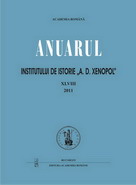Repatrierea Germanilor din Ţările Baltice şi teritoriile româneşti, 1939-1941
THE REPATRIATION OF THE GERMANS FROM BALTIC STATES AND ROMANIAN TERITORIES, 1939-1941
Author(s): Bogdan-Alexandru SchiporSubject(s): History
Published by: Editura Academiei Române
Keywords: non-aggression pact; demographic mutations; Baltic States; German ethnics
Summary/Abstract: Beyond aspects strictly related to political or territorial issues, the Soviet-German non-aggression pact signed on August 23, 1939 generated important demographic mutations in Eastern Europe, hard to foresee prior to the outbreak of the war. After the delineation of the spheres of influence and the new possessions of Germany and Soviet Union, Berlin tried to determine the German ethnics in Eastern Europe, including from territories obtained by the Soviet Union, to choose to return to Germany, considered the true homeland. This decision was the basis for an ample program for the repatriation of the German ethnics from the Baltic States or Romania. In the particular case of Romania, which we have in view, the program was developed in 1940, but we must take into consideration a few distinct elements. First, as we have emphasized in the title, we avoided a formulation such as “the repatriation of the Germans in Romania,” choosing the formula “the Romanian territories.” The choice is not incidental, since 1940 is the year when Romania was forced to renounce territories in favour of the Soviet Union, Bulgaria and Hungary, territories also inhabited by significant communities of German ethnics, as was the case of Bukovina or Bessarabia. The German authorities, who had agreed the previous year to the annexation of Bessarabia to the Soviet Union, asked Moscow on this occasion to solve the problem of the almost 100000 German ethnics who lived in the region between Prut and Dnester. Berlin was intrigued by the fact that the Soviet ultimatum addressed to Romania referred equally to Bukovina and the Hertza area, territories on which also lived many people of German origin. Their issue could be solved directly with the Soviets, but the Reich’s leaders also took into account the repatriation of the Germans from Romania. But, obviously, we never lose sight of the fact that the repatriation of the Germans from Bukovina, Bessarabia or Dobrudja represented only a part of a much larger process which cannot be fully understood if we do not compare it, for example, to similar phenomena in the Baltic countries. The repatriation of the German ethnics from Latvia, Estonia or Lithuania can emphasize both similarities and distinctions which, together, can form a more accurate image on an uprooted ethnic group seeking a new identity in the old homeland, animated by promises, hopes and dreams of a better life.
Journal: Anuarul Institutului de Istorie »A.D. Xenopol« - Iaşi
- Issue Year: XLIX/2012
- Issue No: 49
- Page Range: 341-347
- Page Count: 16
- Language: Romanian

